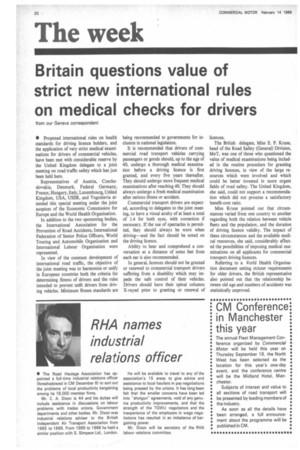The week
Page 22

If you've noticed an error in this article please click here to report it so we can fix it.
Britain questions value of strict new international rules on medical checks for drivers
from our Geneva correspondent • Proposed international rules on health standards for driving licence holders, and the application of very strict medical examinations for drivers of commercial vehicles, have been met with considerable reserve by the United Kingdom delegate to a joint meeting on road traffic safety which has just been held here.
Representatives of Austria, Czechoslovakia, Denmark, Federal Germany, France, Hungary, Italy, Luxembourg, United Kingdom, USA, USSR, and Yugoslavia attended this special meeting under the joint auspices of the Economic Commission for Europe and the World Health Organisation.
In addition to the two sponsoring bodies, the International Association for the Prevention of Road Accidents, International Federation of Senior Police Officers, World Touring and Automobile Organisation and International Labour Organisation were represented.
In view of the constant development of international road traffic, the objective of the joint meeting was to harmonize or unify in European countries both the criteria for determining fitness of drivers and the rules intended to prevent unfit drivers from driving vehicles. Minimum fitness standards are being recommended to governments for inclusion in national legislation.
It is recommended that drivers of commercial road transport vehicles carrying passengers or goods should, up to the age of 40, undergo a thorough medical examination before a driving licence is first granted, and every five years thereafter. They should undergo more frequent medical examinations after reaching 40. They should always undergo a fresh medical examination after serious illness or accident.
Commercial transport drivers are expected, according to delegates to the joint meeting, to have a visual acuity of at least a total of 1.4 for both eyes, with correction if necessary. If the use of spectacles is permitted, they should always be worn when driving—and the fact should be noted on the driving licence.
Ability to hear and comprehend a conversation at a distance of some feet from each ear is also recommended.
In general, licences should not be granted or renewed to commercial transport drivers suffering from a disability which may impede the safe control of their vehicles. Drivers should have their spinal columns X-rayed prior to granting or renewal of licences.
The British delegate, Miss E. P. Kruse, head of the Road Safety (General) Division, MoT, was one of those who questioned the value of medical examinations being included in the routine procedure for granting driving licences, in view of the large resources which were involved and which could be better invested in more urgent fields of road safety. The United Kingdom, she said, could not support a recommendation which did not promise a satisfactory benefit-cost ratio.
Miss Kruse pointed out that circumstances varied from one country to another regarding both the relation between vehicle fleets and the population, and the duration of driving licence validity. The impact of these circumstances and the available medical resources, she said, considerably affected the possibilities of imposing medical examinations on all applicants for commercial transport driving licences.
Referring to a World Health Organisation document setting stricter requirements for older drivers, the British representative also pointed out that the relationship between old age and numbers of accidents was statistically unproved.


















































































































